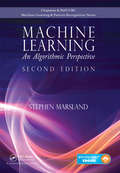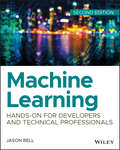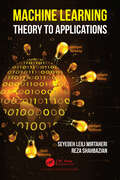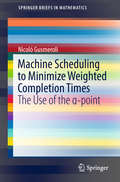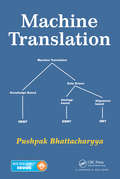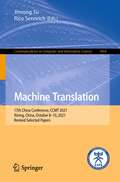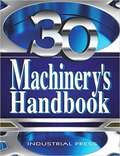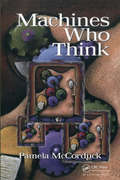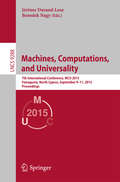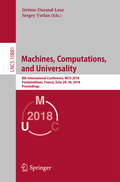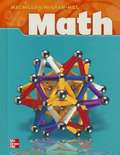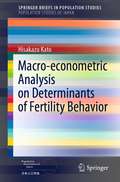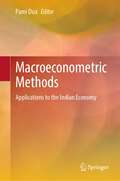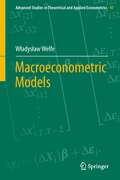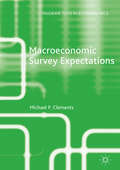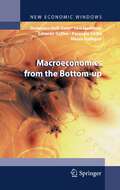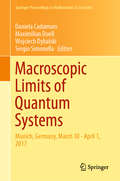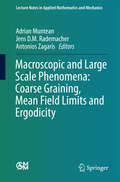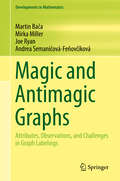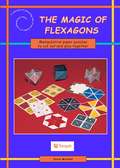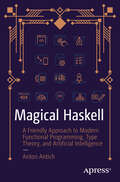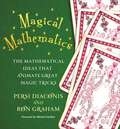- Table View
- List View
Machine Learning: An Algorithmic Perspective, Second Edition
by Stephen MarslandA Proven, Hands-On Approach for Students without a Strong Statistical FoundationSince the best-selling first edition was published, there have been several prominent developments in the field of machine learning, including the increasing work on the statistical interpretations of machine learning algorithms. Unfortunately, computer science students
Machine Learning: Hands-On for Developers and Technical Professionals
by Jason BellDig deep into the data with a hands-on guide to machine learning with updated examples and more! Machine Learning: Hands-On for Developers and Technical Professionals provides hands-on instruction and fully-coded working examples for the most common machine learning techniques used by developers and technical professionals. The book contains a breakdown of each ML variant, explaining how it works and how it is used within certain industries, allowing readers to incorporate the presented techniques into their own work as they follow along. A core tenant of machine learning is a strong focus on data preparation, and a full exploration of the various types of learning algorithms illustrates how the proper tools can help any developer extract information and insights from existing data. The book includes a full complement of Instructor's Materials to facilitate use in the classroom, making this resource useful for students and as a professional reference. At its core, machine learning is a mathematical, algorithm-based technology that forms the basis of historical data mining and modern big data science. Scientific analysis of big data requires a working knowledge of machine learning, which forms predictions based on known properties learned from training data. Machine Learning is an accessible, comprehensive guide for the non-mathematician, providing clear guidance that allows readers to: Learn the languages of machine learning including Hadoop, Mahout, and Weka Understand decision trees, Bayesian networks, and artificial neural networks Implement Association Rule, Real Time, and Batch learning Develop a strategic plan for safe, effective, and efficient machine learning By learning to construct a system that can learn from data, readers can increase their utility across industries. Machine learning sits at the core of deep dive data analysis and visualization, which is increasingly in demand as companies discover the goldmine hiding in their existing data. For the tech professional involved in data science, Machine Learning: Hands-On for Developers and Technical Professionals provides the skills and techniques required to dig deeper.
Machine Learning: Theory to Applications
by Seyedeh Leili Mirtaheri Reza ShahbazianThe book reviews core concepts of machine learning (ML) while focusing on modern applications. It is aimed at those who want to advance their understanding of ML by providing technical and practical insights. It does not use complicated mathematics to explain how to benefit from ML algorithms. Unlike the existing literature, this work provides the core concepts with emphasis on fresh ideas and real application scenarios. It starts with the basic concepts of ML and extends the concepts to the different deep learning algorithms. The book provides an introduction and main elements of evaluation tools with Python and walks you through the recent applications of ML in self-driving cars, cognitive decision making, communication networks, security, and signal processing. The concept of generative networks is also presented and focuses on GANs as a tool to improve the performance of existing algorithms. In summary, this book provides a comprehensive technological path from fundamental theories to the categorization of existing algorithms, covers state-of-the-art, practical evaluation tools and methods to empower you to use synthetic data to improve the performance of applications.
Machine Scheduling to Minimize Weighted Completion Times
by Nicoló GusmeroliThis work reviews the most important results regarding the use of the α-point in Scheduling Theory. It provides a number of different LP-relaxations for scheduling problems and seeks to explain their polyhedral consequences. It also explains the concept of the α-point and how the conversion algorithm works, pointing out the relations to the sum of the weighted completion times. Lastly, the book explores the latest techniques used for many scheduling problems with different constraints, such as release dates, precedences, and parallel machines. This reference book is intended for advanced undergraduate and postgraduate students who are interested in scheduling theory. It is also inspiring for researchers wanting to learn about sophisticated techniques and open problems of the field.
Machine Translation
by Pushpak BhattacharyyaThis book compares and contrasts the principles and practices of rule-based machine translation (RBMT), statistical machine translation (SMT), and example-based machine translation (EBMT). Presenting numerous examples, the text introduces language divergence as the fundamental challenge to machine translation, emphasizes and works out word alignment, explores IBM models of machine translation, covers the mathematics of phrase-based SMT, provides complete walk-throughs of the working of interlingua-based and transfer-based RBMT, and analyzes EBMT, showing how translation parts can be extracted and recombined to automatically translate a new input.
Machine Translation: 17th China Conference, CCMT 2021, Xining, China, October 8–10, 2021, Revised Selected Papers (Communications in Computer and Information Science #1464)
by Jinsong Su Rico SennrichThis book constitutes the refereed proceedings of the 17th China Conference on Machine Translation, CCMT 2020, held in Xining, China, in October 2021. The 10 papers presented in this volume were carefully reviewed and selected from 25 submissions and focus on all aspects of machine translation, including preprocessing, neural machine translation models, hybrid model, evaluation method, and post-editing.
Machinery's Handbook (30th Edition)
by Erik ObergFor more than 100 years, Machinery's Handbook has been the most popular reference work in metalworking, design, engineering and manufacturing facilities, and technical schools and colleges throughout the world. It is universally acknowledged as an extraordinarily authoritative, comprehensive, and practical tool, providing its users with the most fundamental and essential aspects of sophisticated manufacturing practice. The 30th edition of the "Bible of the Metalworking Industries" contains major revisions of existing content, as well as new material on a variety of topics. It is the essential reference for mechanical, manufacturing, and industrial engineers, designers, draftsmen, toolmakers, machinists, engineering and technology students, and the serious home hobbyist. New to the 30th Edition: Expanded metrology section, including v-blocks and micrometer, vernier, and dial calipers. New fluid power section covering pneumatic,hydraulic, and vacuum theory and applications. New powder metallurgy section, including additive manufacturing. Even more useful specs, including tap drill sizes for Unified threads, reaming allowances for drilling, mesh and grit sizes, rules for figuring tapers, and assembly with pins and studs. Recently added information on sheet metal and presses, keys and keyways, shaft alignment, taps and tapping, helical coil screw thread inserts, metric screw threads, miniature screws, fluid mechanics, solid geometry, statistics, calculating hole coordinates and thread dimensions, and distinguishing between bolts and screws. Plus many thoroughly reworked and renovated sections throughout. Comprehensive tables of contents at the beginning of each section and extensive indexing. Hundreds of new and thousands of refined and redone illustrations and equations. Updated standards. Expanded metric content.
Machines Who Think: A Personal Inquiry into the History and Prospects of Artificial Intelligence
by Pamela McCorduck Cli CfeThis book is a history of artificial intelligence, that audacious effort to duplicate in an artifact what we consider to be our most important property—our intelligence. It is an invitation for anybody with an interest in the future of the human race to participate in the inquiry.
Machines, Computations, and Universality
by Jérôme Durand-Lose Benedek NagyThis book constitutes the refereed proceedings of the 7th International Conference on Machines, Computations, and Universality, MCU 2015, held in Famagusta, North Cyprus, in September 2015. The 10 revised full papers presented together with 4 invited talks were carefully reviewed and selected from 23 submissions. MCU explores computation in the setting of various discrete models (Turing machines, register machines, cellular automata, tile assembly systems, rewriting systems, molecular computing models, neural models, etc. ) and analog and hybrid models (BSS machines, infinite time cellular automata, real machines, quantum computing, etc. ).
Machines, Computations, and Universality: 8th International Conference, MCU 2018, Fontainebleau, France, June 28–30, 2018, Proceedings (Lecture Notes in Computer Science #10881)
by Jérôme Durand-Lose Sergey VerlanThis book constitutes the refereed proceedings of the 8th International Conference on Machines, Computations, and Universality, MCU 2018, held in Fontainebleau, France, in June 2018. The 9 revised full papers presented together with 5 invited talks were carefully reviewed and selected from numerous submissions. MCU explores computation in the setting of various discrete models (Turing machines, register machines, cellular automata, tile assembly systems, rewriting systems, molecular computing models, neural models, concurrent systems, etc.) and analog and hybrid models (BSS machines, infinite time cellular automata, real machines, quantum computing, etc.).
Macmillan/McGraw-Hill Math (Grade #5)
by Carol E. Malloy Lois Gordon Moseley Douglas H. Clements Yuria Orihuela Robyn R. SilbeyGrade 5 Math Textbook
Macro-econometric Analysis on Determinants of Fertility Behavior (SpringerBriefs in Population Studies)
by Hisakazu KatoThe book comprises three chapters, with each chapter assigned various type data such as time series data, cross sectional data and panel data. The purpose of this book is to explore the economic and social determinant factors of fertility. Unlike many previous empirical analyses of fertility and the related demographic events, this research has three characteristics. The first is that the relationship between fertility and labor participation by females is thoroughly considered, with much discussion about the structural change between those factors. The second is that time series analysis such as the Bayesian vector autoregressive (BVAR) model or co-integration concepts is applied to explore the determinant factors of fertility. The third is that the effectiveness of public policies related to improve fertility is confirmed. In recent years, micro-econometric analysis has become popular; however, this book takes another approach from the perspective of macro- or semi-macro-econometrics.
Macroeconometric Methods: Applications to the Indian Economy
by Pami DuaThis book provides empirical applications of macroeconometric methods through discussions on key issues in the Indian economy. It deals with issues of topical relevance in the arena of macroeconomics. The aim is to apply time series and financial econometric methods to macroeconomic issues of an emerging economy such as India. The data sources are given in each chapter, and students and researchers may replicate the analyses.The book is divided into three parts—Part I: Macroeconomic Modelling and Policy; Part II: Forecasting the Indian Economy and Part III: Business Cycles and Global Crises. It provides a holistic understanding of the techniques with each chapter delving into a relevant issue analysed using appropriate methods—Chapter 1: Introduction; Chapter 2: Macroeconomic Modelling and Bayesian Methods; Chapter 3: Monetary Policy Framework in India; Chapter 4: Determinants of Yields on Government Securities in India; Chapter 5: Monetar y Transmission in the Indian Economy; Chapter 6: India’s Bilateral Export Growth and Exchange Rate Volatility: A Panel GMM Approach; Chapter 7: Aggregate and Sectoral Productivity Growth in the Indian Economy: Analysis and Determinants; Chapter 8: Forecasting the INR/USD Exchange Rate: A BVAR Framework; Chapter 9: Forecasting India’s Inflation in a Data-Rich Environment: A FAVAR Study; Chapter 10: A Structural Macroeconometric Model for India; Chapter 11: International Synchronization of Growth Rate Cycles: An Analysis in Frequency Domain; Chapter 12: Inter-Linkages Between Asian and U.S. Stock Market Returns: A Multivariate GARCH Analysis; Chapter 13: The Increasing Synchronization of International Recessions.Since the selection of issues is from macroeconomic aspects of the Indian economy, the book has wide applications and is useful for students and researchers of fields such as applied econometrics, time series econometrics, financial econometrics, forecasting methods and macroeconomics.
Macroeconometric Models
by Władysław WelfeThis book gives a comprehensive description of macroeconometric modeling and its development over time. The first part depicts the history of macroeconometric model building, starting with Jan Tinbergen's and Lawrence R. Klein's contributions. It is unique in summarizing the development and specific structure of macroeconometric models built in North America, Europe, and various other parts of the world. The work thus offers an extensive source for researchers in the field. The second part of the book covers the systematic characteristics of macroeconometric models. It includes the household and enterprise sectors, disequilibria, financial flows, and money market sectors.
Macroeconomic Forecasting in the Era of Big Data: Theory and Practice (Advanced Studies in Theoretical and Applied Econometrics #52)
by Peter FulekyThis book surveys big data tools used in macroeconomic forecasting and addresses related econometric issues, including how to capture dynamic relationships among variables; how to select parsimonious models; how to deal with model uncertainty, instability, non-stationarity, and mixed frequency data; and how to evaluate forecasts, among others. Each chapter is self-contained with references, and provides solid background information, while also reviewing the latest advances in the field. Accordingly, the book offers a valuable resource for researchers, professional forecasters, and students of quantitative economics.
Macroeconomic Survey Expectations (Palgrave Texts in Econometrics)
by Michael P. ClementsWhy should we be interested in macroeconomic survey expectations? This important book offers an in-depth treatment of this question from a point of view not covered in existing works on time-series econometrics and forecasting. Clements presents the nature of survey data, addresses some of the difficulties posed by the way in which survey expectations are elicited and considers the evaluation of point predictions and probability distributions. He outlines how, from a behavioural perspective, surveys offer insight into how economic agents form their expectations.
Macroeconomics
by R. Glenn Hubbard Anthony O'BrienThe relevance of macroeconomics shown through real-world business examples. The authors of Macroeconomics help foster interest in the discipline’s concepts, and make the key principles of this topic relevant to students’ lives by demonstrating how real businesses use macroeconomics to make decisions every day. With ever-changing US and world economies, the 7th Edition has been updated with the latest developments using new real-world business and policy examples. Regardless of their future career path -- opening an art studio, trading on Wall Street, or bartending at the local pub, students will benefit from understanding the macroeconomic forces behind their work.
Macroeconomics from the Bottom-up
by Saul Desiderio Edoardo Gaffeo Pasquale Cirillo Domenico Delli Gatti Mauro GallegatiThis book arose from our conviction that the NNS-DSGE approach to the analysis of aggregate market outcomes is fundamentally flawed. The practice of overcoming the SMD result by recurring to a fictitious RA leads to insurmountable methodological problems and lies at the root of DSGE models' failure to satisfactorily explain real world features, like exchange rate and banking crises, bubbles and herding in financial markets, swings in the sentiment of consumers and entrepreneurs, asymmetries and persistence in aggregate variables, and so on. At odds with this view, our critique rests on the premise that any modern macroeconomy should be modeled instead as a complex system of heterogeneous interacting individuals, acting adaptively and autonomously according to simple and empirically validated rules of thumb. We call our proposed approach Bottom-up Adaptive Macroeconomics (BAM). The reason why we claim that the contents of this book can be inscribed in the realm of macroeconomics is threefold: i) We are looking for a framework that helps us to think coherently about the interrelationships among two or more markets. In what follows, in particular, three markets will be considered: the markets for goods, labor and loanable funds. In this respect, real time matters: what happens in one market depends on what has happened, on what is happening, or on what will happen in other markets. This implies that intertemporal coordination issues cannot be ignored. ii) Eventually, it's all about prices and quantities. However, we are mostly interested in aggregate prices and quantities, that is indexes built from the dispersed outcomes of the decentralized transactions of a large population of heterogeneous individuals. Each individual acts purposefully, but she knows anything about the levels of prices and quantities which clear markets in the aggregate. iii) In the hope of being allowed to purport scientific claims, BAM relies on the assumption that individual purposeful behaviours aggregates into regularities. Macro behaviour, however, can depart radically from what the individual units are trying to accomplish. It is in this sense that aggregate outcomes emerge from individual actions and interactions.
Macroeconomics, 6th Custom Edition for Temple University
by Michael ParkinMacroeconomics seeks to put clarity and understanding in the grasp of the student with a careful and vivid exploration of the tension between self-interest and the social interest, the role and power of incentives--of opportunity cost and marginal benefit--and demonstrating the possibility that markets supplemented by other mechanisms might allocate resources efficiently. Parkin students begin to think about issues the way real economists do and learn how to explore difficult policy problems and make more informed decisions in their own economic lives.
Macroscopic Limits of Quantum Systems: Munich, Germany, March 30 - April 1 2017 (Springer Proceedings in Mathematics & Statistics #270)
by Daniela Cadamuro Maximilian Duell Wojciech Dybalski Sergio SimonellaBased on the workshop of the same name, this proceedings volume presents selected research investigating the mathematics of collective phenomena emerging from quantum theory at observable scales. Featured contributions from leading scientists provide a thorough overview of current and active research. Methods from functional analysis, spectral theory, renormalization group theory, and variational calculus are used to prove rigorous results in quantum physics. Topics include superconductivity and mathematical aspects of the BCS theory, the Jellium model and Bose-Einstein condensation, among others. Presenting technical details in an accessible way, this book serves as an introduction to research for advanced graduate students and is suitable for specialists in mathematical physics.The workshop “Macroscopic Limits of Quantum Systems” was held over three days in the spring of 2017 at the Technical University of Munich. The conference celebrated the achievements of Herbert Spohn and his reception of the Max Planck Medal.
Macroscopic and Large Scale Phenomena: Coarse Graining, Mean Field Limits and Ergodicity
by Adrian Muntean Jens Rademacher Antonios ZagarisThis book is the offspring of a summer school school "Macroscopic andlarge scale phenomena: coarse graining, mean field limits and ergodicity", which washeld in 2012 at the University of Twente, the Netherlands. The focus lies onmathematically rigorous methods for multiscale problems of physical origins. Each of the four book chapters is based on a set of lectures deliveredat the school, yet all authors have expanded and refined their contributions. Francois Golsedelivers a chapter on the dynamics of large particle systems in the mean fieldlimit and surveys the most significant tools and methods to establish suchlimits with mathematical rigor. Golse discusses in depth a variety of examples,including Vlasov--Poisson and Vlasov--Maxwell systems. Lucia Scardia focuseson the rigorous derivation of macroscopic models using $\Gamma$-convergence, amore recent variational method, which has proved very powerful for problems inmaterial science. Scardia illustrates this by various basic examples and a moreadvanced case study from dislocation theory. Alexander Mielke'scontribution focuses on the multiscale modeling and rigorous analysis ofgeneralized gradient systems through the new concept of evolutionary$\Gamma$-convergence. Numerous evocative examples are given, e. g. , relating toperiodic homogenization and the passage from viscous to dry friction. Martin Göll and EvgenyVerbitskiy conclude this volume, taking a dynamical systems and ergodic theoryviewpoint. They review recent developments in the study of homoclinic pointsfor certain discrete dynamical systems, relating to particle systems viaergodic properties of lattices configurations.
Magic and Antimagic Graphs: Attributes, Observations and Challenges in Graph Labelings (Developments in Mathematics #60)
by Mirka Miller Joe Ryan Martin Bača Andrea Semaničová-FeňovčíkováMagic and antimagic labelings are among the oldest labeling schemes in graph theory. This book takes readers on a journey through these labelings, from early beginnings with magic squares up to the latest results and beyond.Starting from the very basics, the book offers a detailed account of all magic and antimagic type labelings of undirected graphs. Long-standing problems are surveyed and presented along with recent results in classical labelings. In addition, the book covers an assortment of variations on the labeling theme, all in one self-contained monograph.Assuming only basic familiarity with graphs, this book, complete with carefully written proofs of most results, is an ideal introduction to graph labeling for students learning the subject. More than 150 open problems and conjectures make it an invaluable guide for postgraduate and early career researchers, as well as an excellent reference for established graph theorists.
Magic of Flexagons: Paper Curiosities to Cut Out & Make
by David MitchellFlexagons are made by folding paper in certain ways and when they are flexed, turned and unfolded in different ways, they show puzzling and curious effects. Hidden inside a flexagon are a number of concealed faces and the challenge is to discover how to flex them into view smoothly and with confidence. Some of this extensive collection are in the form of puzzles to be solved, others have rather mysterious properties.
Magical Haskell: A Friendly Approach to Modern Functional Programming, Type Theory, and Artificial Intelligence
by Anton AntichDiscover a unique and fun approach to adopting modern typed functions programming patterns. This book uses playful metaphors and examples to help you learn Haskell through imagination, building on math without relying on imperative crutches or technical complexity. You’ll use math to build completely different Typed Functional patterns from the ground up and understand the link between building Mathematics through Types and constructing Haskell as a programming language. Intended for working with various applications, especially AI-powered apps, the book gently builds up to what are normally considered complex and difficult concepts all without needing a PhD to understand them. Illustrative explanations will guide you to tackle monads, using monad transformer stacks to structure real programs, foldable and traversable structures, as well as other Type classes. This book will also help you structure programs efficiently and apply your own abstractions to real-life problem domains. Next, you’ll explore exciting advancements in AI, including building with OpenAI APIs, creating a terminal chatbot, adding web functionality, and enhancing with retrieval-augmented generation. Finally, you’ll delve into AI multi-agents and future directions using Arrows abstraction, reinforcing Haskell’s design. Magical Haskell is a solution for programmers who feel limited by imperative programming languages but are also put off by excessively mathematical approaches. What You Will Learn Grasp a solid math foundation without complex technicalities for Types and Typeclasses. Solve problems via a typed functional approach and understand why it’s superior to what’s available in the imperative language world (“if it compiles, it runs”). Build your own abstractions to efficiently resolve problems in any given domain. Develop AI frameworks in Haskell, including chatbots, web functionality, and retrieval-augmented generation. Who This Book Is For Haskell programmers of all levels and those interested in Type Theory.
Magical Mathematics: The Mathematical Ideas That Animate Great Magic Tricks
by Persi Diaconis Ron GrahamThe mathematics behind some of the world's most amazing card tricksMagical Mathematics reveals the secrets of fun-to-perform card tricks—and the profound mathematical ideas behind them—that will astound even the most accomplished magician. Persi Diaconis and Ron Graham provide easy, step-by-step instructions for each trick, explaining how to set up the effect and offering tips on what to say and do while performing it. Each card trick introduces a new mathematical idea, and varying the tricks in turn takes readers to the very threshold of today's mathematical knowledge.Diaconis and Graham tell the stories—and reveal the best tricks—of the eccentric and brilliant inventors of mathematical magic. The book exposes old gambling secrets through the mathematics of shuffling cards, explains the classic street-gambling scam of three-card Monte, traces the history of mathematical magic back to the oldest mathematical trick—and much more.
